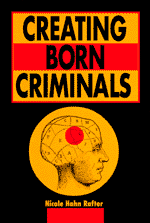

![]()
![]()

In Creating Born Criminals, Rafter argues for the development of a new term, 'eugenic criminology,' to address this lack of scholarship on the historical connections between biological explanations of criminal behavior, eugenics and social policy studies. Using archival research, Rafter begins unraveling these relationships through an historical analysis of early American turf wars between Hervey Wilbur and the institutional superintendents in the Association of Medical Officers of the American Institutions for Idiotic and Feeble-Minded Persons (AMO) concerning who could claim professional jurisdiction over the mentally retarded. Wilbur promoted training centers that taught skills so that mentally retarded persons could eventually re-enter their respective communities. He lost the battle to the AMO, however, an organization arguing that individuals then deemed 'idiots' and 'lunatics' required life-long custodial care and, eventually, the development of institutions that prevented those individuals from reproducing.
In the late 1800s and early 1900s, American social problems were increasingly explained through a focus on 'bad heredity' (then referred to as degeneracy). The fashionable notion of degeneracy also paralleled the growing intellectual prominence of Darwin and Spencer, and the then-popular study by Dugdale of an infamous criminal family, the Jukes. Socially marginalized groups such as feeble-minded women of reproductive age then became easy targets for eugenic institutionalization. The AMO eventually helped promote the criminalization of all mentally retarded persons, and Rafter notes that during this period scientific discourses began linking 'mental idiocy' to both 'moral insanity' and heredity. Indeterminate sentencing was soon being promoted for 'born' criminals, a concept Rafter traces to the development of American criminal anthropology, psychology and IQ testing. In the early 1900s, the idea of the "feebleminded criminal" was replaced with that of the 'defective delinquent,' and by the 1920s the term had grown in popularity with social workers, judges and corrections officers.
In the book's final chapters, Rafter discusses the increasing prominence of psychiatry in the early 1900s as sounding the death knell for eugenic criminology. However, this did not stop 'Defective Delinquent Legislation' (Chapter 10) from being instituted in New York and Massachusetts in the early decades of the twentieth century. Although both biologically-based explanations for crime and the eugenics movement began falling into disfavor in the 1920s, Rafter notes that 'eugenic criminology left behind institutions for defective delinquents (IDDs) that continued to operate for another fifty years' (p. 212).
Similar to her accomplishments in previous books, Rafter has written a thorough historical analysis of under-analyzed trends in criminology, a book particularly appropriate for graduate students studying criminological theory and the history of criminal justice. Rafter also brings this history to life by discussing the personalities of key individuals and the social context which gave rise to eugenic trends in criminology (several photographs of the individuals, institutions and original documents that Rafter discusses also add well to the textual account). Additionally, her book shows why an understanding of the historical connections between eugenics and criminology sheds light on contemporary debates over biological explanations of crime, particularly over the uses that could be made of the Human Genome Project. Rafter's account presents ample evidence that biological explanations of crime in the U.S. have resulted in unsavory social policy frequently directed at vulnerable populations, and that we appreciate these trends lest history repeat itself.
Kurt Borchard
University of Nebraska at Kearney